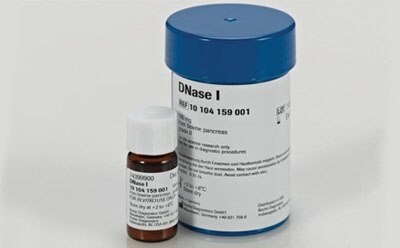Nucleases (DNases and RNases)

The function of nucleases (DNases and RNases) includes the enzymatic breakdown of DNA and RNA and is necessary for numerous research applications. For example, the purification of proteins and specific nucleic acids often requires the digestion of DNA, RNA or both. Viscosity problems resulting from high DNA concentrations and enzymatic cell dissociation methods are often enhanced utilizing DNase. We offer a complete selection of high-purity nucleases to meet most digestion requirements.
Products
| DNA | DNA | Hybrid | ||||||
| Non-Specific Nucleases | Endo-nuclease | Exo-nuclease | Single Strand |
Double Strand | RNA | RNA | Yields 3'-Phosphate | Yields 5'-Phosphate |
| Turbonuclease | X | X | X | X | X | |||
| DNase I | X | X | X | X | ||||
| DNase II | X | X | X | X | ||||
| Micrococcal Nuclease | X | X | X | X | X | |||
| Nuclease P1 | X | X | X | |||||
| Nuclease S1 | X | X | X | X | X | |||
| Phosphodiesterase I | X | X | ||||||
| Phosphodiesterase II | X | X | X | X | X | |||
| RNase A | X | X | X | |||||
| RNase H | X | X | X | |||||
| RNase T1 | X | X | X | |||||
| Ribonuclease Optimized Blend | X | X | X | X |
Restriction Endonucleases
Nucleases for DNA and RNA Digestion
Our nucleases vary by cleavage specificity as well as by properties such as pH optimum, allowing the investigator to choose the digestive enzyme best suited to experimental needs. Deoxyribonuclease I from mammalian sources, for example, yields products with terminal 5’ P1 from Penicillium citrinum - degrades single-stranded DNA and RNA, but not double-stranded DNA. Ribonuclease A will hydrolyze any RNA contaminating protein samples or preparations of plasmid DNA. Many of these enzymes have additional uses in molecular biology. For example, DNase I “nicks” DNA to allow incorporation of labeled bases. RNase A is a tool in the RNase protection assay that measures the abundance of specific mRNAs.
Deoxyribonuclease I and Deoxyribonuclease II DNase Enzymes
Deoxyribonuclease I catalyzes the endonucleolytic cleavage of double and single stranded DNA to yield 5'-phosphodinucleotide and 5'-phosphooligonucleotide end-products. The product of hydrolysis is a complex mixture of 5'-phosphate mononucleotides and oligonucleotides. In the presence of magnesium ions, DNase I attacks each strand of DNA independently and the cleavage sites are random. In the presence of manganese (II), DNase I cleaves both strands of DNA at approximately the same site. Most protocols use magnesium ion with DNase I but for specific purposes, manganese is used. In addition, deoxyribonuclease II catalyzes the endonucleolytic cleavage of double and single stranded DNA to yield nucleoside 3'-phosphates and 3'-phosphooligonucleotide end-products. The pH range for activity is 4.0 to 6.5, with only about 15% at pH 6.5. with an optimum of pH 5.0. The optimum stability of the enzyme is at pH 5 - 5.5, with rapid inactivation at pH 8.5 at 30 °C. We offer a broad collection of DNase enzymes to support a variety of sample types and applications. Whether it is lyophilized or in liquid form, some of our DNases include significantly low concentrations of RNase or proteases to protect your sample from undesired digestion.
Ribonuclease A, Ribonuclease H, and Ribonuclease T1 RNase Enzymes
Ribonuclease A catalyzes the endonucleolytic cleavage of RNA to yield nucleoside 3'-phosphates and 3'-phosphooligonucleotides ending in Cp or Up. Activators of RNase A include potassium and sodium salts. The optimal temperature for activity is 60 °C, although the enzyme does exhibit activity from 15-70 °C. The pH optimum is 7.6, with an activity range of 6-10. The highest activity is exhibited with single stranded RNA. RNase A is a very stable enzyme and can withstand temperatures up to 100 °C. At 100 °C, RNase A is most stable between pH 2.0 and 4.5. Ribonuclease H specifically hydrolyzes the phosphodiester bonds of RNA in RNA:DNA duplexes to generate products with 3'-hydroxyl and 5'-phosphate ends. It degrades only the RNA component of the DNA-RNA hybrid (RNA that is hydrogen bonded to a complementary DNA strand).
In addition, Ribonuclease T1 catalyzes the two-stage endonucleolytic cleavage of RNA to yield nucleoside 3'-phosphates and 3'-phosphooligonucleotides ending mainly in Gp. In the reaction, cleavage occurs between the 3'-phosphate group of a guanidine ribonucleotide and 5'-hydroxyl of the adjacent nucleotide. The initial product is a 2':3' cyclic phosphate nucleoside that is hydrolyzed to the corresponding 3'-nucleoside phosphate. In solution, it is resistant to heat (100 °C for 10 minutes at pH 6) and acid, but unstable in alkaline solution (>pH 9). It should be noted that the reaction catalyzed by the enzyme cannot be stopped by heating the reaction mixture to 100 °C. We offer a broad collection of RNase enzymes, to support the variety of sample types and applications. Whether it is lyophilized or in liquid form, some of our RNases include significantly low concentrations of proteases to protect your sample from undesired protein cleavage.
To continue reading please sign in or create an account.
Don't Have An Account?